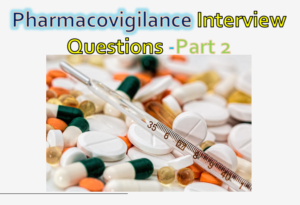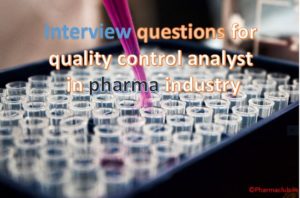Pharmacovigilance interview questions and answers-Part 2:
Pharmacovigilance interview questions are prepared here in two parts. Part 1 covers most of pharmacovigilance interview questions from technical point of view. Part 2 contains technical as well as physiology, medical terms and computer questions.
These are remaining questions continuation to the pharmacovigilance interview questions part 1.
- What do you know about aggregate reporting?
Ans) It is a procedure that collects all the cumulative safety data of a medicinal product on a periodic basis from a wide variety of sources. These data is submitted to regulatory authorites.
As long as If the company medicinal product is in market of any where in the world. Aggregate safety reports of that medicinal product should be submitted to regulatory authorities.
Explain about Interventional studies and Non interventional studies?
Ans) Interventional study: This is a type of clinical trail. Treatment/Intervention is assigned to one or more groups in the clinical study. Another group may not receive the treatment (if it is a Control group otherwise If it is active control group, this group also receive the medication). All these details will be mentioned in the study protocol in advance and evaluates the medicinal product effect on health related outcome.
Non-interventional study: Also known as Observational study. Participants in this study receives medicinal product in usual manner. These studies helpful to determine various aspects of medicinal product use. In these studies Treatment strategy is not decided advance in the protocol. Any additional diagnostic methods are not used (only clinical samples are collected as the part of their regular normal clinical practice) to measure efficacy. Usually questionnaires, interviews used to collect the data.
Related: Job opportunities after M pharm Pharmcology
What do you know about signal and its types?
Ans) Signal is a reported information based on a causal relationship. This information may be not known till now or incompletely reported previously. For generating a signal, 2 or more than 2 reports are required.
Three types of signals are available.
- Confirmed signals
- False signals
- Unconfirmed signal: need further information.
What do you know about causality and mention causality assessing methods?
Ans) Causality is all about relatedness or relationship between a set of factors mainly of drug and adverse event. For assessing the causality, several methods are available.
e.g: WHO assessment scale, European ABO system, Kramer scale etc.
Note: These pharmacovigilance interview questions and answers helpful mainly for freshers also some of the questions for experienced people. While attending a pharmacovigilance interview, you may asked different questions which are related to PV and other working point of view (like basic computer questions. E.g You have to use computer while, so these questions as well questions from your personal education background may also be expected).
If you are trying to attend a pharmacovigilance interview , you should aware of all these pharmacovigilance interview questions and answers. We hope that this pharmacovigilance interview questions will assist you face the interview successfully.
Related: Phases of clinical trials -Overview
- What are sources of Adverse Event Reports?
Ans) Adverse events reported by following sources.
- Spontaneous reporting by healthcare professionals (Physicians/ Pharmacists/Nurse etc.)
- Solicited reports from Clinical trails
- Stimulated reports through patient support programs, marketing surveys, patient registries, disease management and medical chart reviews etc.
Apart from these questions, Usually pharmacology questions asked in interviews generally. Questions and answers as follows.
These are the common physiology and pharmacology question and answers you should know before attending the pharmacovigilance interview.
What are life threatening diseases? and explain it?
Ans) These are the dangerous diseases which are able to cause death. Usually these diseases are chronic diseases and most of these diseases/medical conditions don’t have proper curable treatment. E.g HIV/AIDS, Diabetes, Hypertension, Cancer, Neurological conditions etc.
- What do you know about diabetes and mention the drugs used for its treatment?
Ans) Diabetes is a metabolic disorder. There are two types of diabetes.
- Type 1 diabetes: In this type, insulin is not produced from the pancreas. Insulin produced cells may be damaged due to several reasons like due to immunity disorders or infections etc. Direct insulin injections are used in this disorder.
- Type 2 diabetes: In this type, Insulin produced in the body, Type 2 DM patients unable to use this insulin properly. This is the most common diabetes.
Most commonly used are Metformin, Gliclazide, Glimperimide, simvastatin etc.
- Gestational diabetes: This is disorder occur in pregnancy.
What is the normal blood pressure and explain about Hypertension?
Ans) 120/80 considered as normal blood pressure. 120 indicates systolic blood pressure and 80 diastolic blood pressure.
High blood pressure(Hypertenstion) is a long term medical disorder. If pressure of the blood is high enough i.e 140/90 on arteries, it is called as hypertension. Excess salt, excess body weight, smoking and alcohol are the risk factors for high BP.
Expand ECG, COPD disease,EEG, FSH harmone, OGTT test, HIV, ICU and NIDDM?
Ans) ECG- Electrocardiogram
COPD- Chronic Obstructive Pulmonary Disease
EEG- Electroencephalogram
OGTT- Oral Glucose Tolerance Test
HIV- Human Immunovirus
ICU- Intensive Care Unit
NIDDM- Non Insulin Dependent Diabetes Melletus.
Tell me about various parenteral routes of administration?
Ans) Intravenous (IV) route – Drug delivered directly into a vein.
Intramuscular (IM) route- Drug injected into the muscle.
Subcutaneous (SC) route- Drug delivered through the subcutaneous layer located the below the dermis and epidermis layer of the skin.
Intra arterial (IA) route- Drug injected through artery which specific for a particular organ.
Intra articular route: Drug injected in joint space avoiding the systemic circulation.
Intrathecal route: Drug injected in to the spinal canal or subarachnoid space .
Intradermal route: Medicine injected through the skin dermis layer.
Explain the functions of Liver, lungs and kidney?
Ans) Liver: It plays key metabolic functions in the body like carbohydrates, fats and protein metabolism. It detoxify the blood chemicals. It stores the minerals, vitamins and glycogen. Liver produces the bile salts for breaking down the fats in the small intestine.
Lungs: The main function of the lungs is to exchange the gases during the respiration. It provides the oxygen to the blood (RBC) and removes carbon dioxide from the blood (RBC).
Kidneys: It plays a key role in balancing the water fluids level. It continuously filter the blood and do excretion or retention of the minerals depend upon the body requirement.
Related: Courses offered after B pharmacy
Apart from these questions, you are may be asked about basics of computer short cuts
Mention a few keyboard shortcuts except cut, copy and paste?
Ans) Ctrl +A : Select all, Ctrl + B: Bold, Ctrl + D: Go to Font, Ctrl + E: Align the line or selected text to the center, Ctrl + F: Find, Ctrl + G: Go to, Ctrl + H: Replace, Ctrl + I: Italics, Ctrl + N: New document, Ctrl + P: Print,
Windows+ D : Go to desktop
Related: Clinical sas interview questions
Please share this post to your friends and feel free to comment below.

